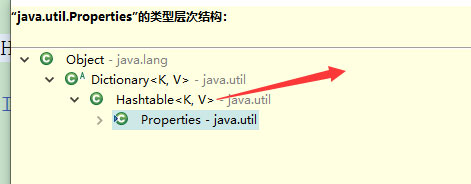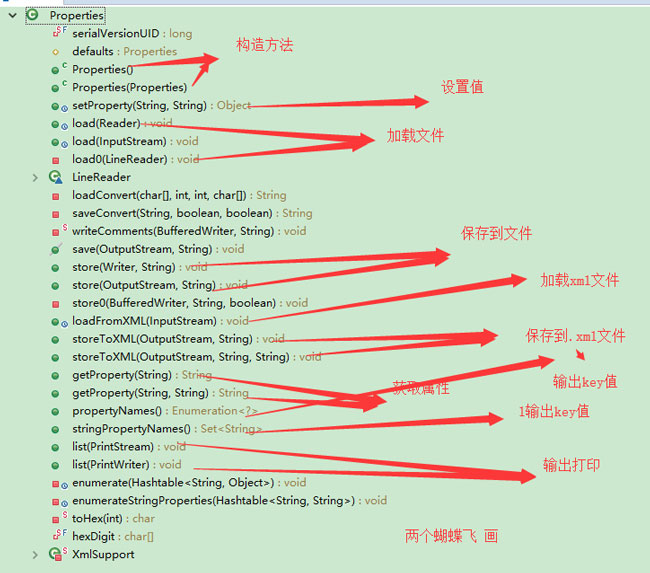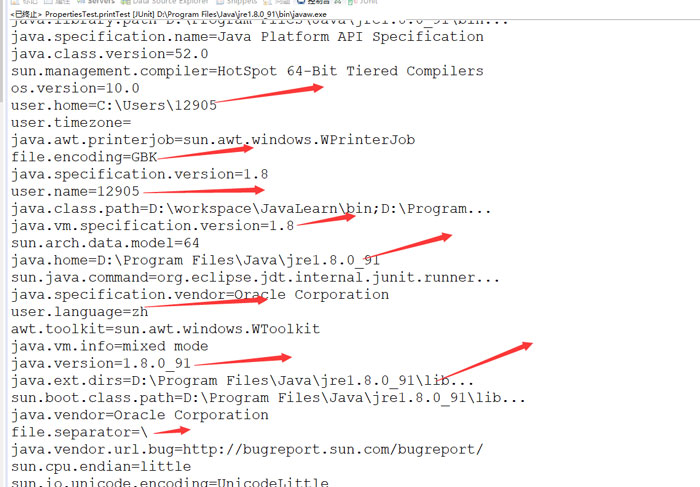淺談Java中Properties類(lèi)的詳細(xì)使用
Properties 類(lèi)位于 java.util.Properties ,是Java 語(yǔ)言的配置文件所使用的類(lèi), Xxx.properties 為Java 語(yǔ)言常見(jiàn)的配置文件,如數(shù)據(jù)庫(kù)的配置 jdbc.properties, 系統(tǒng)參數(shù)配置 system.properties。 這里,講解一下Properties 類(lèi)的具體使用。以key=value 的 鍵值對(duì)的形式進(jìn)行存儲(chǔ)值。 key值不能重復(fù)。

繼承了Hashtable 類(lèi),以Map 的形式進(jìn)行放置值, put(key,value) get(key)
主要方法:

這里只講解一些常用的形式。
二、打印JVM參數(shù)JVM 中可以獲取Properties, 來(lái)打印輸出 JVM 所了解的屬性值。用list() 方法,打印到控制臺(tái)。
@Testpublic void printTest(){ Properties properties=System.getProperties(); properties.list(System.out);}
常見(jiàn)的有:

在src 目錄下,放置 jdbc.properties 文件,是數(shù)據(jù)庫(kù)的配置文件。
jdbc.driver=com.mysql.jdbc.Driver
jdbc.url=jdbc:mysql://localhost:3306/mybatis?characterEncoding=utf8
jdbc.username=root
jdbc.password=abc123
3.1、list輸出到控制臺(tái)用絕對(duì)路徑加載@Testpublic void name1Test(){ try{Properties properties=new Properties();//用的是磁盤(pán)符的絕對(duì)路徑 InputStream input=new BufferedInputStream(new FileInputStream('D:workspaceJavaLearnsrcjdbc.properties'));properties.load(input);properties.list(System.out); }catch(Exception e){e.printStackTrace(); }}
url 被截取了。

@Testpublic void name2Test(){ try{Properties properties=new Properties(); // 用/文件名, / 表示根目錄InputStream input=PropertiesTest.class.getClass().getResourceAsStream('/jdbc.properties');properties.load(input);Enumeration<String> names=(Enumeration<String>) properties.propertyNames();while(names.hasMoreElements()){ //這是key值 String key=names.nextElement(); String value=properties.getProperty(key); System.out.println(key+'='+value);} }catch(Exception e){e.printStackTrace(); }}

@Testpublic void name3Test(){ try{Properties properties=new Properties();//直接寫(xiě)src 類(lèi)路徑下的文件名InputStream input=PropertiesTest.class.getClassLoader().getResourceAsStream('jdbc.properties');properties.load(input);//把key值轉(zhuǎn)換成set 的形式,遍歷setSet<String> names=properties.stringPropertyNames();Iterator<String> iterator=names.iterator();while(iterator.hasNext()){ String key=iterator.next(); String value=properties.getProperty(key); System.out.println(key+'='+value);} }catch(Exception e){e.printStackTrace(); }}

@Testpublic void name3Test(){ try{Properties properties=new Properties();InputStream input=PropertiesTest.class.getClassLoader().getResourceAsStream('jdbc.properties');properties.load(input);//String value=properties.getProperty('jdbc.url');String value=properties.getProperty('jdbc.url1','沒(méi)有該key值');System.out.println('輸出值:'+value); }catch(Exception e){e.printStackTrace(); }}
輸出時(shí),getProperty() 有當(dāng)前的key值,則輸出Key值對(duì)應(yīng)的value 值。如果沒(méi)有key值,則輸出 null 值。后面可以跟 default 值,如果沒(méi)有該值,則輸出設(shè)置的默認(rèn)值。

@Testpublic void writeTest(){ try{Properties properties=new Properties();InputStream input=PropertiesTest.class.getClassLoader().getResourceAsStream('jdbc.properties');properties.load(input);//多添加幾個(gè)值。properties.setProperty('name','兩個(gè)蝴蝶飛');properties.setProperty('sex','男');//properties.put('name','兩個(gè)蝴蝶飛'); 可以用繼承Hashtable 的put 方法寫(xiě)入值// properties.put('sex','男');//將添加的值,連同以前的值一起寫(xiě)入 新的屬性文件里面。OutputStream out=new FileOutputStream('D:jdbc.properties');properties.store(out,'填充數(shù)據(jù)'); }catch(Exception e){e.printStackTrace(); }}

在構(gòu)建輸入流和輸出流時(shí),指定編碼格式, 編碼的格式相同。 如均是 utf-8的形式。
@Testpublic void write2Test(){ try{Properties properties=new Properties();//用絕對(duì)路徑InputStream input=new BufferedInputStream(new FileInputStream('D:workspaceJavaLearnsrcjdbc.properties'));properties.load(new InputStreamReader(input,'utf-8')); //多添加幾個(gè)值。properties.setProperty('name','兩個(gè)蝴蝶飛');properties.setProperty('sex','男');OutputStream output=new FileOutputStream('D:jdbc.properties');OutputStreamWriter out=new OutputStreamWriter(output,'utf-8');properties.store(out,'填充數(shù)據(jù)'); }catch(Exception e){e.printStackTrace(); }}
測(cè)試運(yùn)行之后:

這樣便解決了亂碼的問(wèn)題。
六、加載和導(dǎo)出到xml配置文件6.1、導(dǎo)出到.xml配置文件storeToXML將Properties 類(lèi)中定義的屬性,導(dǎo)出成 .xml 的形式.
@Testpublic void xmlWriteTest(){ try{//處理成編碼樣式。Properties properties=new Properties(); //多添加幾個(gè)值。properties.setProperty('name','兩個(gè)蝴蝶飛');properties.setProperty('sex','男');OutputStream output=new FileOutputStream('D:jdbc.xml');//編碼設(shè)置成utf-8的形式。 properties.storeToXML(output,'填充到xml','utf-8'); }catch(Exception e){e.printStackTrace(); }}
測(cè)試結(jié)果為:

用 <entry> 節(jié)點(diǎn) key為屬性, 后面跟值來(lái)進(jìn)行輸入。可按照這種形式,繼續(xù)添加。
6.2、導(dǎo)出XML配置文件loadFromXML@Testpublic void xmlReadTest(){ try{Properties properties=new Properties();InputStream input=new BufferedInputStream(new FileInputStream('D:jdbc.xml'));properties.loadFromXML(input);properties.list(System.out); }catch(Exception e){e.printStackTrace(); }}

以上就是淺談Java中Properties類(lèi)的詳細(xì)使用的詳細(xì)內(nèi)容,更多關(guān)于Java Properties的資料請(qǐng)關(guān)注好吧啦網(wǎng)其它相關(guān)文章!
相關(guān)文章:
1. ajax請(qǐng)求后臺(tái)得到j(luò)son數(shù)據(jù)后動(dòng)態(tài)生成樹(shù)形下拉框的方法2. 如何通過(guò)vscode運(yùn)行調(diào)試javascript代碼3. HTML <!DOCTYPE> 標(biāo)簽4. JS數(shù)據(jù)類(lèi)型判斷的幾種常用方法5. 用Python自動(dòng)下載網(wǎng)站所有文件6. WML語(yǔ)言的基本情況7. python中str內(nèi)置函數(shù)用法總結(jié)8. Ajax實(shí)現(xiàn)頁(yè)面無(wú)刷新留言效果9. JSP+Servlet實(shí)現(xiàn)文件上傳到服務(wù)器功能10. python爬蟲(chóng)使用requests發(fā)送post請(qǐng)求示例詳解

 網(wǎng)公網(wǎng)安備
網(wǎng)公網(wǎng)安備